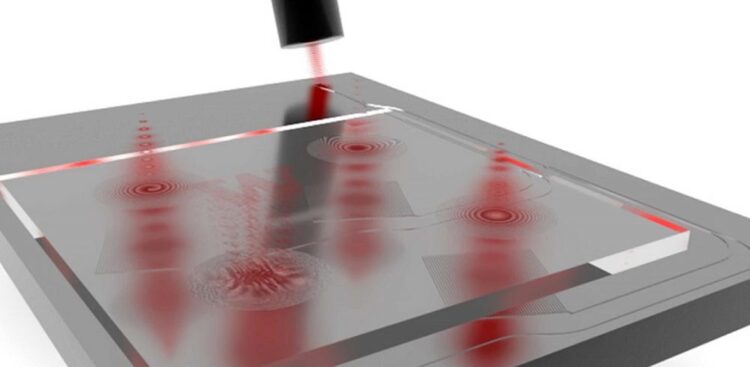Multifunctional interface enables manipulation of light waves in free space

A photonic integrated circuit guides input light received from an optical fiber to a separate meta-optics chip, which bends the light into desired shapes in free space.
Credit: Tanguy et al., doi 10.1117/1.APN.2.3.036012.
Combining meta-optics with a photonic integrated circuit, the innovative interface can shape multiple light beams simultaneously in free space.
Recent technological advances have given us a remarkable ability to manipulate and control light waves, opening up numerous applications in various fields, such as optical communication, sensing, imaging, energy, and quantum computing. At the heart of this progress are photonic structures that can control light waves, either at the chip level in the form of photonic integrated circuits (PICs) or in free space as meta-optics. Combining these structures allows for the creation of compact optical systems. The PICs can be used to make subtle changes to the light wave, such as the manipulation of its phase and intensity to achieve a desired output, which can then be guided in free space by meta-optics. Such combined systems can control qubits for quantum computing and power light detection, as well as ranging systems like the ones used for autonomous vehicle navigation and mapping.
Since PICs use nanometer-scale waveguides to confine and direct light, coupling their light to and from larger devices, such as optical fibers, is tricky. Grating couplers are commonly used for this purpose because of their grating structure that can diffract light going in or out of the PIC’s waveguides. However, these devices can only shape the light wave to a certain degree, limiting their applicability.
In view of this shortcoming, meta-optics capable of manipulating optical wavefronts with arbitrary shapes have been suggested to couple light from PICs. Although this approach is promising, no multifunctional coupling between PIC and free space has yet been reported.
Now, in a study published in Advanced Photonics Nexus, researchers from the University of Washington, have demonstrated a chip-scale hybrid PIC/meta-optical platform consisting of a photonic integrated circuit with gratings below a separate meta-optics chip. The PIC comprises 16 identical gratings arranged in a two-dimensional array, each with an aperture size of 300 micrometers and coupled to an optical fiber with a grating coupler. These gratings serve as waveguides and direct light from the fiber to the meta-optics chip which shapes and outputs light to free space, parallel to the input light.
“Using an array of low-loss meta-optics, we have developed a flexible and interchangeable interface between a photonic integrated circuit and free space,” says senior author Associate Professor Arka Majumdar from the University of Washington in Seattle.
Using this platform, the researchers were able to simultaneously pass light through 14 PIC gratings and then shape the corresponding beam with 14 different meta-optics, such as meta-lenses, vortex beam generators, extended depth of focus lenses, and holograms.
“Meta-optics has the ability to shape optical wavefronts to create a multifunctional interface between free-space optics and integrated photonics. This study exploits that. All the light beams that come out of the PIC are identical, but by placing different meta-optics on top of each grating, we were able to simultaneously manipulate the beams individually,” explains Majumdar.
In their experiments with different meta-optics, the researchers found that the device operated with high accuracy and reliability, even without prior knowledge of the input light or the need for precise alignment between the two chips. Specifically, they achieved a diffraction limited spot of three micrometers and a holographic image with a peak signal-to-noise ratio greater than 10 decibels.
The remarkable feature of the proposed device is its ability to change its functionality simply by replacing the meta-optics linked to the PIC. This allows for a wide range of possibilities for controlling and modifying light beams with a high degree of error tolerance. The potential applications of this interface are manifold, and include beam steering, structured light generation, optical trapping, and manipulation of cold atom qubits.
Read the Gold Open Access article by Q. A. A. Tanguy et al., “Multifunctional interface between integrated photonics and free space,” Adv. Photon. Nexus 2(3) 036012, doi 10.1117/1.APN.2.3.036012.
Journal: Advanced Photonics Nexus
DOI: 10.1117/1.APN.2.3.036012
Article Title: Multifunctional interface between integrated photonics and free space
Article Publication Date: 23-May-2023
Media Contact
Daneet Steffens
SPIE–International Society for Optics and Photonics
daneets@spie.org
Office: 360-685-5478
All latest news from the category: Physics and Astronomy
This area deals with the fundamental laws and building blocks of nature and how they interact, the properties and the behavior of matter, and research into space and time and their structures.
innovations-report provides in-depth reports and articles on subjects such as astrophysics, laser technologies, nuclear, quantum, particle and solid-state physics, nanotechnologies, planetary research and findings (Mars, Venus) and developments related to the Hubble Telescope.
Newest articles

Durable, Efficient, Sustainable: The Rise of Cerium Oxide Thermal Switches
Groundbreaking cerium oxide-based thermal switches achieve remarkable performance, transforming heat flow control with sustainable and efficient technology. Cerium Oxide-Based Thermal Switches Revolutionize Heat Flow Control Thermal switches, which electrically control…

How Industrial Robots are Reducing Emissions in Global Manufacturing
A new study explores the intersection of industrial automation and environmental sustainability, focusing on the role of industrial robots in reducing the carbon intensity of manufacturing exports. The research demonstrates…

Patients Can Heal Through Precise, Personalized Bioceramic Grafts
A recent review is transforming the landscape of craniomaxillofacial bone regeneration with the introduction of personalized bioceramic grafts. This pioneering research explores the fabrication and clinical potential of synthetic grafts…



